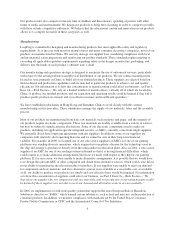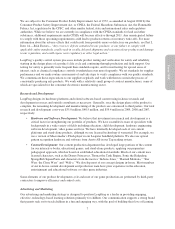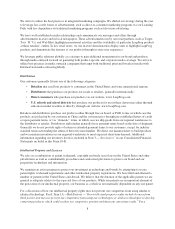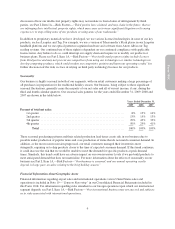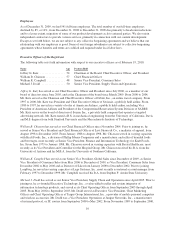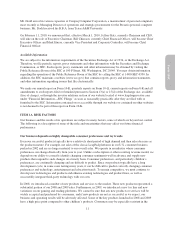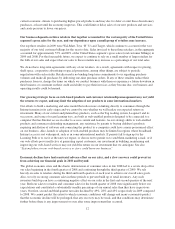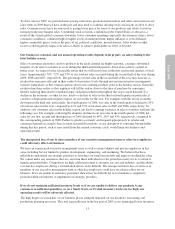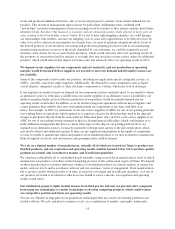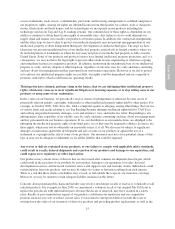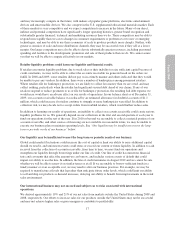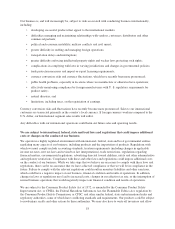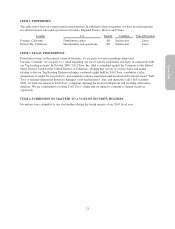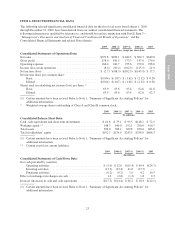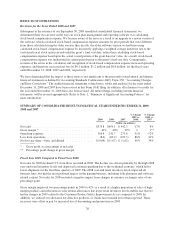LeapFrog 2009 Annual Report Download - page 26
Download and view the complete annual report
Please find page 26 of the 2009 LeapFrog annual report below. You can navigate through the pages in the report by either clicking on the pages listed below, or by using the keyword search tool below to find specific information within the annual report.cost of defending against litigation related to the defective products. Further, as a result of recent recalls and
safety issues related to products of a number of manufacturers in the toy industry, some of our retailer customers
have been increasing their testing requirements of the products we ship to them. These additional requirements
may result in delayed or cancelled shipments, increased logistics and quality assurance costs, or both, which
could adversely affect our operations and financial results. In addition, recalls or post-manufacturing repairs by
other companies in our industry could affect consumer behavior and cause reduced purchases of our products and
increase our quality assurance costs in allaying consumer concerns.
Privacy concerns about our web-connected products and related software and applications could harm
our reputation and hinder adoption of these products.
By using the Internet-based LeapFrog Learning Path application, information captured by our web-connected
products about a child’s performance and activities will be transferred and stored on our website servers. Due to
privacy, confidentiality and security concerns, parents may not want our products collecting information about
their child’s activities and performance and may not feel comfortable uploading and storing this information on
our website servers. If these concerns prevent parents from accepting or adopting our connected products, the
sales of our products and our business results could suffer. In addition, if the confidentiality of such information
stored on our website servers is compromised or breached by third parties or our mismanagement, our reputation
could be tarnished, which in turn could adversely affect our operating results.
System failures in our web-based services or store could harm our business.
The Internet-based aspects of our business have grown substantially in strategic importance to our overall
business. However, we still have limited experience operating an e-commerce system and providing web services
in connection with our products. Any failure to provide a positive user experience could have a negative impact
on our reputation, sales and consumer relationships. If demand for accessing our websites exceeds the capacity
we have planned to handle peak periods or if other technical issues arise when customers attempt to use these
systems to purchase products or to access features or content for our increasing number of web-connected
products, then customers could be inconvenienced or become dissatisfied with our products. For example, in the
past, our website has suffered service disruptions and delays from time to time, particularly during the December
holidays, due, for example, to the number of consumers attempting to access it and errors in the systems
processing transactions and account creations. Any significant disruption to our website or internal computer
systems or malfunctions related to transaction processing on our e-commerce store or content management
systems could result in a loss of potential or existing customers and sales. This risk has become more acute as we
rely increasingly on our web-based consumer relationship management efforts to drive sales and position our
business. Any significant system failures in our web-based services or store could have a significant adverse
effect on our sales and operating plan.
Although our systems have been designed to reduce downtime in the event of outages or catastrophic
occurrences, they remain vulnerable to damage or interruption from earthquakes, floods, fires, power loss,
telecommunication failures, terrorist attacks, computer viruses, computer denial-of-service attacks, and similar
events. Some of our systems are not fully redundant, and our disaster recovery planning is not sufficient for all
eventualities. Our systems are also subject to break-ins, sabotage, and intentional acts of vandalism. Despite any
precautions we may take, the occurrence of a natural disaster or other unanticipated problems at our hosting
facilities could result in lengthy interruptions in our services. We do not carry business interruption insurance
sufficient to compensate us for losses that may result from interruptions in our service as a result of system
failures. Any unplanned disruption of our systems could result in adverse financial impact to our operations.
If we are unable to compete effectively with existing or new competitors, our sales and market share could
decline.
We currently compete primarily in the learning toy and electronic learning aids category of the U.S. toy industry
and, to some degree, in the overall U.S. and international toy industry. We believe we compete to some extent,
16


